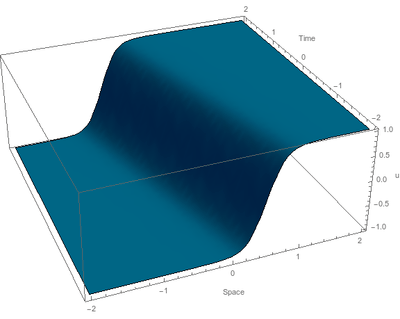Front (physics)
In physics, a front[1][2] is a solution of an spatially extended system connecting two steady states. From dynamical systems point of view, a front correspond to a heteroclinic orbit of the system in the co-mobile frame (or proper frame).


Fronts connecting stable - unstable homogeneous states
The most simple example of front solution connecting a homogeneous stable state with a homogeneous unstable state can be shown in the one-dimensional Fisher-Kolmogorov equation:
that describes a simple model for the density of population. This equation has two steady states, , and . This solution corresponds to extinction and saturation of population. Observe that this model is spatially-extended, because it includes a diffusion term given by the second derivative. The state is stable as a simple linear analysis can show and the state is unstable. There exist a family of front solutions connecting with , and such solution are propagative. Particularly, there exist one solution of the form , where constants, depending only on the coefficient of diffusion and growth constant k.
References
- ↑ Pismen, L. M. (2006). Patterns and interfaces in dissipative dynamics. Berlin: Springer. ISBN 978-3-540-30430-2.
- ↑ Horsthemke, Vicenç Mendéz, Sergei Fedotov, Werner (2010). Reaction-transport systems : mesoscopic foundations, fronts, and spatial instabilities. Heidelberg: Springer. ISBN 978-3642114427.